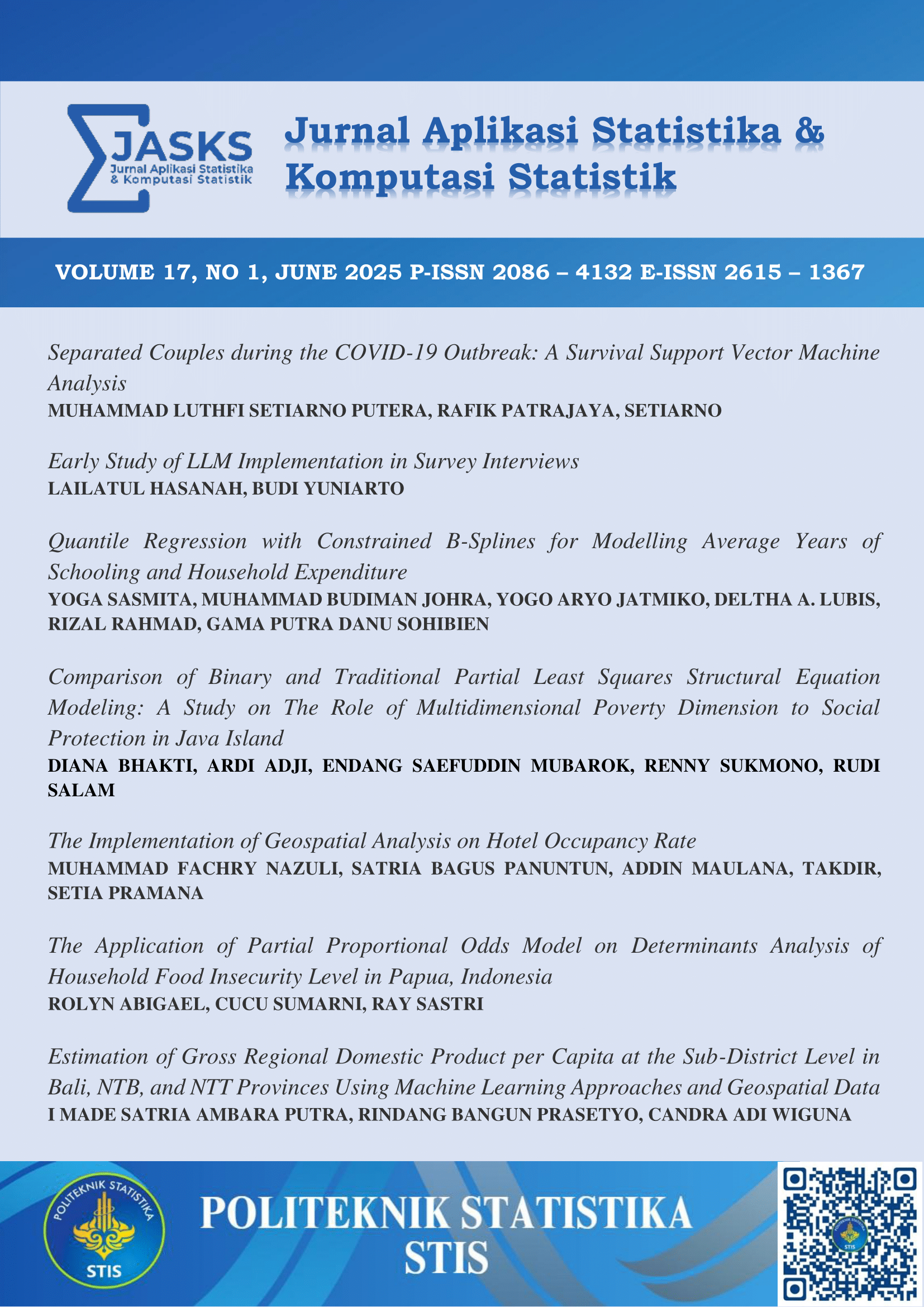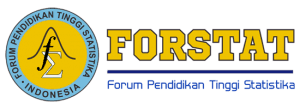Separated Couples during the COVID-19 Outbreak: A Survival Support Vector Machine Analysis
DOI:
https://doi.org/10.34123/jurnalasks.v17i1.739Keywords:
feature selection, dissolution, socio-economic determinants, Survival Support Vector MachineAbstract
Introduction/Main Objectives: The separation between spouses has been rising noticeably in recent years in Palangka Raya, particularly during the COVID-19 outbreak. Background Problems: An analysis of time-to-event on those separations will be undertaken quantitatively using survival analysis by comparing the results yielded by Cox proportional hazards (PH) regression and non-parametric Survival Support Vector Machine (SUR-SVM). Novelty: This work suggests a feature selection method that looks for influencing elements related to the c-index by employing backward elimination. Research Methods: This study's data came from Indonesia's Supreme Court webpage, including a database of separation verdicts from the Palangka Raya Religious Court, spanning from April 2020 to March 2021. The response variables were the time-to-separation (marriage length until separation) (t) and the censored state of the occurrence (?). Finding/Results: Based on SUR-SVM, the factors contributing the most to the separation are the absence of children, unsteady employment of appellants, and finance motive as the primary reason. In terms of concordance index and Akaike Information Criterion (AIC), the SUR-SVM outperformed the Cox proportional hazard model. These values of SUR-SVM were 59.24 and 1899.78, respectively. SUR-SVM correctly classified 59.24% of separations based on the chronological order of events.
Downloads
References
M. A. Widiawaty, K. C. Lam, M. Dede, and N. H. Asnawi, “Spatial differentiation and determinants of COVID-19 in Indonesia,” BMC Public Health, vol. 22, no. 1, p. 1030, May 2022, doi: 10.1186/s12889-022-13316-4.
P. R. Pietromonaco and N. C. Overall, “Implications of social isolation, separation, and loss during the COVID-19 pandemic for couples’ relationships,” Current Opinion in Psychology, vol. 43, pp. 189–194, Feb. 2022, doi: 10.1016/j.copsyc.2021.07.014.
H. Prime, M. Wade, and D. T. Browne, “Risk and resilience in family well-being during the COVID-19 pandemic,” American Psychologist, vol. 75, no. 5, pp. 631–643, 2020, doi: 10.1037/amp0000660.
M. D. Puspitasari and M. Gayatri, “COVID-19 and Marital Dissolution in West Java, Indonesia,” The Family Journal, no. 10664807221124246, 2022, doi: https://doi.org/10.1177/10664807221124246.
I. Rais, “The impact of COVID-19 pandemic on divorce rates among Indonesian Muslim societies,” Indonesian Journal of Islam and Muslim Societies, vol. 11, no. 2, 2021, doi: 10.18326/ijims.v11i2.271-297.
A. Thadathil and S. Sriram, “Divorce, Families and Adolescents in India: A Review of Research,” Journal of Divorce & Remarriage, vol. 61, no. 1, pp. 1–21, 2020, doi: https://doi.org/10.1080/10502556.2019.1586226.
S. Norouzi et al., “Marriage survival in new married couples: A competing risks survival analysis,” PLoS ONE, vol. 17, no. 8, p. e0272908, 2022, doi: https://doi.org/10.1371/journal.pone.0272908.
R. Abdel-Sater, “Marriage Dissolution in the United States: A Survival Analysis Approach,” Journal of Divorce & Remarriage, vol. 63, no. 4, pp. 235–261, 2022, doi: https://doi.org/10.1080/10502556.2022.2042788.
M. Nemati, J. Ansary, and N. Nemati, “Machine-Learning Approaches in COVID-19 Survival Analysis and Discharge-Time Likelihood Prediction Using Clinical Data,” Patterns, vol. 1, no. 5, p. 100074, Aug. 2020, doi: 10.1016/j.patter.2020.100074.
V. Berg, A. Miettinen, M. Jokela, and A. Rotkirch, “Shorter birth intervals between siblings are associated with increased risk of parental divorce,” PLOS ONE, vol. 15, no. 1, p. e0228237, Jan. 2020, doi: 10.1371/journal.pone.0228237.
M. L. S. Putera and S. Setiarno, “Machine learning survival analysis on couple time-to-divorce data,” Desimal: Jurnal Matematika, vol.5, no. 3, Art. no. 3, Dec. 2022, doi: 10.24042/djm.v5i3.13742.
V. Van Belle, K. Pelckmans, S. Van Huffel, and J. A. K. Suykens, “Support vector methods for survival analysis: a comparison between ranking and regression approaches,” Artificial Intelligence in Medicine, vol. 53, no. 2, pp. 107–118, Oct. 2011, doi: 10.1016/j.artmed.2011.06.006.
Md. S. Satu, K. Howlader, M. P. Hosen, N. Chowdhury, and M. A. Moni, “Identifying the Stability of Couple Relationship Applying Different Machine Learning Techniques,” in 2020 11th International Conference on Electrical and Computer Engineering (ICECE), Dec. 2020, pp. 246–249. doi: 10.1109/ICECE51571.2020.9393131.
S. Goli, H. Mahjub, J. Faradmal, and A.-R. Soltanian, “Performance Evaluation of Support Vector Regression Models for Survival Analysis: A Simulation Study,” ijacsa, vol. 7, no. 6, 2016, doi: 10.14569/IJACSA.2016.070650.
S. Lee and H. Lim, “Review of statistical methods for survival analysis using genomic data,” Genomics Inform, vol. 17, no. 4, p. e41, Dec. 2019, doi: 10.5808/GI.2019.17.4.e41.
R. Zhao, Y. Zhuge, K. Camphausen, and A. V. Krauze, “Machine learning based survival prediction in Glioma using large-scale registry data,” Health Informatics Journal, vol. 28, no. 4, p. 14604582221135427, 2022, doi: https://doi.org/10.1177/14604582221135427.
P. Wang, Y. Li, and C. K. Reddy, “Machine Learning for Survival Analysis: A Survey,” ACM Comput. Surv., vol. 51, no. 6, p. 110:1-110:36, Feb. 2019, doi: 10.1145/3214306.
Z. Zhang, J. Reinikainen, K. A. Adeleke, M. E. Pieterse, and C. G. M. Groothuis-Oudshoorn, “Time-varying covariates and coefficients in Cox regression models,” Ann Transl Med, vol. 6, no. 7, p. 121, Apr. 2018, doi: 10.21037/atm.2018.02.12.
A. Sheng and S. K. Ghosh, “Effects of Proportional Hazard Assumption on Variable Selection Methods for Censored Data,” Statistics in Biopharmaceutical Research, vol. 12, no. 2, pp. 199–209, Apr. 2020, doi: 10.1080/19466315.2019.1694578.
D. G. Kleinbaum and M. Klein, “Kaplan-Meier Survival Curves and the Log-Rank Test,” in Survival Analysis?: A Self-Learning Text, Third Edition, in Statistics for Biology and Health. , Springer International Publishing, 2012, pp. 55–96. Accessed: Jan. 27, 2024. [Online]. Available: https://link.springer.com/chapter/10.1007/978-1-4419-6646-9_2
D. D. Prastyo, H. A. Khoiri, S. W. Purnami, Suhartono, S.-F. Fam, and N. Suhermi, “Survival Support Vector Machines: A Simulation Study and Its Health-Related Application,” in Supervised and Unsupervised Learning for Data Science, M. W. Berry, A. Mohamed, and B. W. Yap, Eds., in Unsupervised and Semi-Supervised Learning. , Cham: Springer International Publishing, 2020, pp. 85–100. doi: 10.1007/978-3-030-22475-2_5.
K. Burke, M. C. Jones, and A. Noufaily, “A Flexible Parametric Modelling Framework for Survival Analysis,” Journal of the Royal Statistical Society Series C: Applied Statistics, vol. 69, no. 2, pp. 429–457, 2020, doi: https://doi.org/10.1111/rssc.12398.
P. Chi, Q. Wu, H. Cao, N. Zhou, and X. Lin, “Relationship-oriented values and marital and life satisfaction among Chinese couples,” Journal of Social and Personal Relationships, vol. 37, no. 8–9, pp. 2578–2596, Aug. 2020, doi: 10.1177/0265407520928588.
D. A. Widyastari, P. Isarabhakdi, P. Vapattanawong, and M. Völker, “Marital Dissolution in Postmodern Java, Indonesia: Does Early Marriage Increase the Likelihood to Divorce?,” Journal of Divorce & Remarriage, vol. 61, no. 8, pp. 556–573, Nov. 2020, doi: 10.1080/10502556.2020.1799308.















